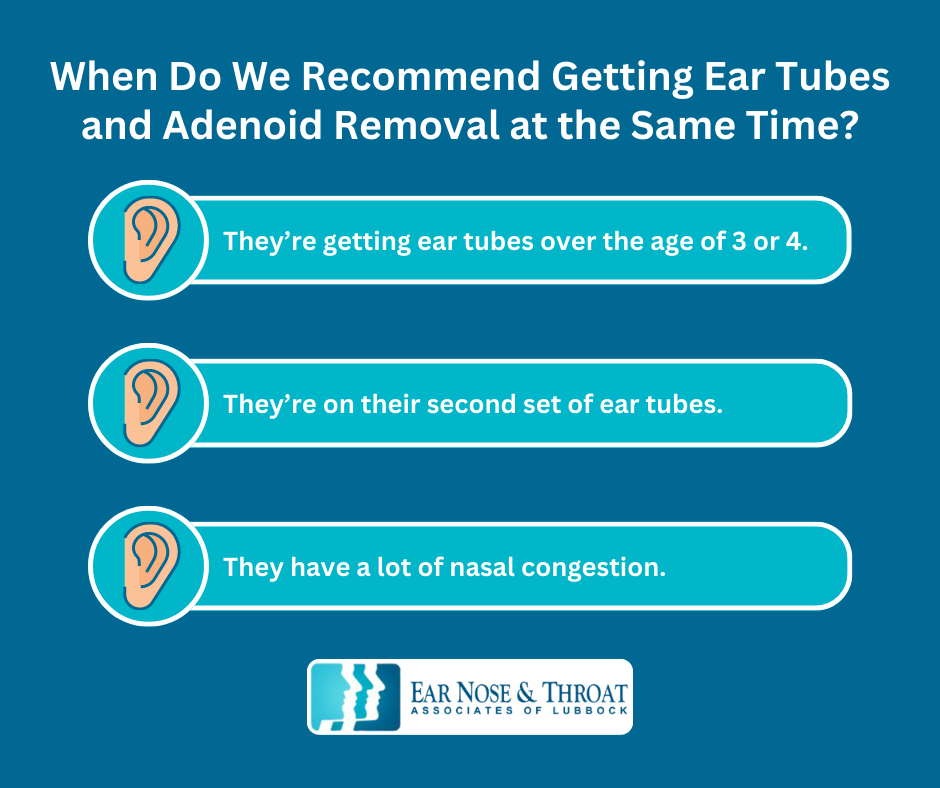When Do We Recommend Combining Ear Tube Placement and Adenoid Removal?

If you’re trying to determine the best solution for your child’s chronic ear infections, having your ENT perform an adenoidectomy and ear tube placement simultaneously could be your best bet.
Although the thought of any extra surgery may make you nervous, we’ll explain when and why it’s a good idea to combine the procedures for ear tubes and adenoid removal.
Why Combine Ear Tube Placement and Adenoid Removal?
Before we talk about why we combine these two surgeries, we’ll quickly explain what each one is and why we typically do it:
- Ear tube placement is a simple procedure in which we make a small incision in each eardrum to drain built-up fluid. We then insert tiny tubes into the incisions, which allow continued drainage for six to 12 months and reduce the likelihood of infections. This procedure is ideal for kids with chronic or recurrent ear infections.
- An adenoidectomy is a procedure in which we remove the adenoids, which are smaller clusters of lymph tissue behind the nose and roof of the mouth. Because of their position, swollen adenoids block the openings of the sinuses and/or eustachian tubes, leading to sinus and ear infections. When kids have swollen adenoids, chronic sinus infections, or eustachian tube dysfunction symptoms, we often recommend this procedure.
Now back to the original question: Why combine the two?
Several studies show that children who get their adenoids removed are less likely to experience new fluid buildup behind their eardrums after their tubes come out.
In short, opting for both ear tubes and adenoid removal reduces the likelihood of further ear infections and consequences like ear pain or hearing loss.
When Do We Recommend Getting Ear Tubes and Adenoid Removal at the Same Time?
We might recommend that your child get an adenoidectomy with an ear tube placement if:
- They’re getting ear tubes over the age of three or four.
- They’re on their second set of ear tubes.
- They have a lot of nasal congestion.

What to Expect During Ear Tube Placement and Adenoid Removal
We only perform adenoidectomies in the operating room under general anesthesia, so your child will be asleep for the entirety of both procedures.
The ear tube placement is extremely quick. First, we make a small incision in the front lower portion of one eardrum and suction out any infected fluid before slipping a small tube into the incision. We then repeat the same process in the other ear, and it’s finished!
The adenoidectomy is also fairly quick, taking only about 10 minutes. We access the adenoids through the mouth, carefully removing them from behind the palate using suctioning instruments or cautery.
What to Expect During Recovery
Ear tube placement recovery is not painful and doesn’t involve any changes to the normal routine. Recovery from an adenoidectomy may sound worrisome, but it doesn’t actually cause much pain. In fact, it’s only about one-tenth as uncomfortable as recovery from a tonsillectomy, and prescription pain medication is usually unnecessary. However, your child may be disoriented or grumpy as the anesthesia wears off.
Children typically feel normal after a few days, with minimal symptoms outside of some short-term nasal congestion and bad breath.
Conclusion
Though having two procedures at once, especially for a child, can sound alarming, ear tubes and adenoid removal are thankfully very simple surgeries with long track records of safety and success. We hope the information above helps you rest easy if your ENT recommends combining these two quick procedures!
Dr. Cuthbertson is a physician at Ear Nose & Throat Associates of Lubbock. He joined the team at ENT Lubbock from Houston, where he was chief resident of the prestigious Bobby R. Alford Department of Otolaryngology at Baylor College of Medicine. He is board certified in Otolaryngology and Head & Neck Surgery and has quickly built a reputation, not only as an extremely skilled surgeon, but as an approachable and compassionate clinician adept in the newest standards and technologies. Learn more about Dr. Cuthbertson.
Categories:








